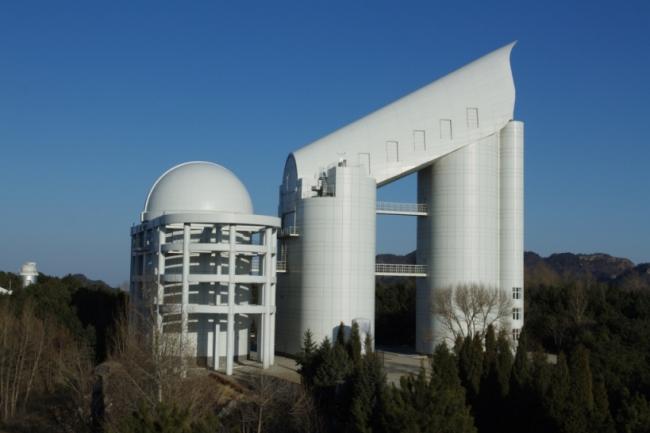
A photo of the Large Aperture Multi-Object Spectroscopic Telescope (LAMOST). Astronomers used LAMOST to discover the first known stellar-mass-sized black hole with a mass larger than about sixty solar-masses.
Most galaxies are thought to host a supermassive black hole at their nucleus, and dozens have been indirectly measured using techniques ranging from imaging (the most famous recent example using the Event Horizon Telescope) to modeling the motion of matter that orbits them. Our Milky Way, for example, has a four million solar-mass black hole at its center; the most extreme examples are estimated to have as much as ten billion solar-masses. At the extreme other end of the mass scale, X-ray observations of matter accreting onto stellar-mass black holes from orbiting companion stars have measured about sixty cases whose masses are a few to ten solar-masses. Gravitational wave detections have so far made roughly a dozen convincing detections of black holes with masses from a few to dozens of solar-masses. The wide gap between these stellar mass sized objects and supermassive ones in galaxy cores is striking and thought to be due to their different origins: stellar-mass black holes are the result of stars going supernova (stars are smaller than about sixty solar-masses) while supermassive black holes, though more mysterious, are thought to grow from mergers and massive accretion.
CfA astronomer Rosanne Di Stefano was a member of a team of astronomers that announced in the latest issue of Nature the discovery of a stellar-mass black hole in a binary star system with a very hot star with a period of 78.9 days and a separation of about one astronomical unit, the widest separation known. The scientists used an optical spectrometer to search for periodic velocity changes in the spectra of each of three thousand target stars known to be members of binaries and thought likely to host an extreme companion. Each target has been measured twenty-six times since the project's start in 2016 using LAMOST (Large Aperture Multi-Object Spectroscopic Telescope). One star in particular, designated LB-1, was found to have a large, unseen companion. Analysis of followup observations with much higher spectral resolution instruments determined its mass to be about sixty-eight solar-masses, with an uncertainly of about ten solar-masses due in large part to the uncertainty in the viewing angle of the orbit.
This massive object is almost surely a black hole because there are no stars this massive (any that might form would have exploded as supernova) but that leaves the origin of this object as something of a puzzle. The team considers several possibilities by varying the mass of the progenitor star, its winds (winds make it lose mass), details of the supernova process, and more complicated initial binary star configurations. In the end, they conclude that some of the more unusual but possible alternatives offer a consistent scenario, thereby shedding new light not only on the population of black holes in this mass range, but also on extreme situations of stellar collapse and binary star evolution. The discovery also signals the likelihood that other black holes will be discovered by this technique, with corresponding insights into how they form.
"A Wide Star–Black-Hole Binary System from Radial-Velocity Measurements," Liu, J. et al., Nature, 575, 618, 2019.